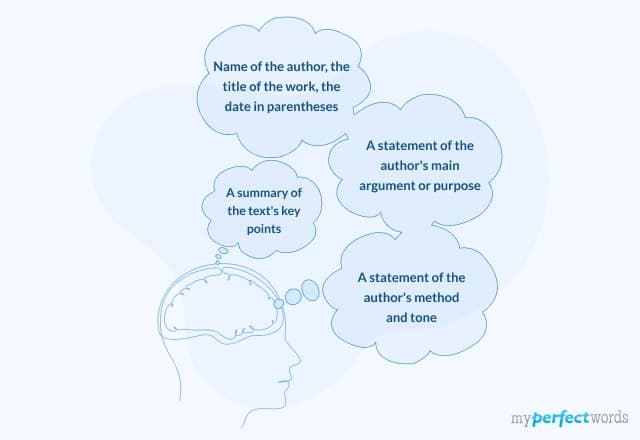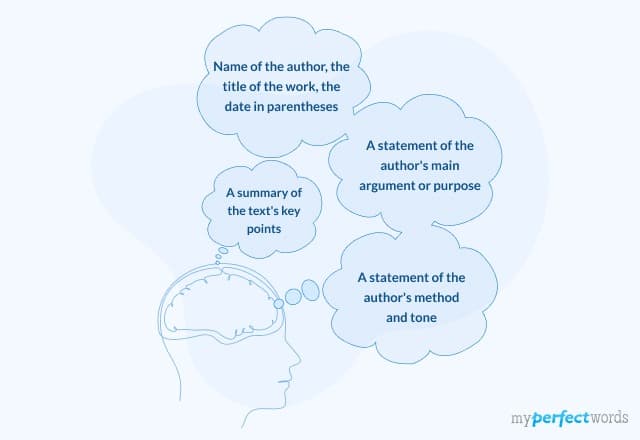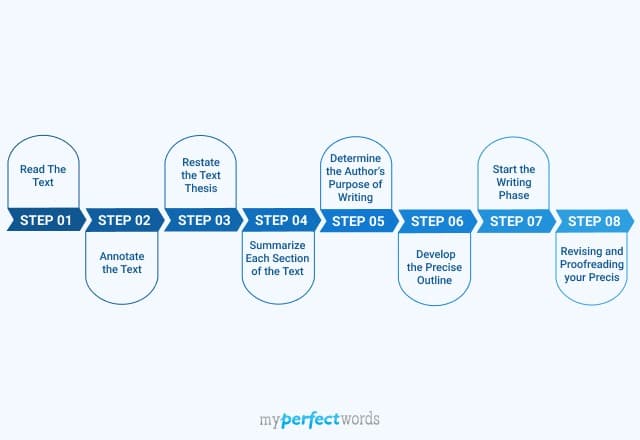Picture this: you're handed a dense article, and your professor expects you to not just understand it but to distill its essence with clarity and precision.
Sounds challenging, right?
That's where rhetorical precis comes into play. Rhetorical precis are like the secret code for comprehension and analysis of those complex articles.
In this guide, we'll discuss how to write a perfect rhetorical precis. We will break down the step-by-step process with examples. So make sure you read through the end to understand the basics of writing a rhetorical precis.
Let’s get started!
On This Page![]()
- 1. What is Rhetorical Precis?
- 2. How to Write Rhetorical Precis?
- 3. Rhetorical Precis Format
- 4. Rhetorical Precis Example
- 5. Tips for Writing a Good Rhetorical Precis
What is Rhetorical Precis?
Looking at the rhetorical precis definition:
A rhetorical precis is a concise and structured four-sentence paragraph summary that captures the essential elements of a written or spoken text.
Rhetorical precis is a powerful tool that helps you break down and understand complex texts. It's like creating a condensed roadmap for the main ideas of an article. In simple terms, it's a structured summary that captures the author's key points, purpose, evidence, and style.
Think of it as a decoder – turning complex passages into clear, manageable insights.
Origin and Historical Context
Originating from the Latin word "praecisus," meaning precise or concise. It embodies the essence of refining lengthy content into manageable summaries. Over time, it evolved into a structured approach, emphasizing clarity in articulating the core elements of scholarly works.
Importance of Rhetorical Precis
- They break down complex texts for clearer understanding.
- They teach how to identify the main ideas and key arguments.
- Rhetorical precis enhances the ability to articulate ideas concisely and coherently.
- They encourage deeper engagement with academic material.
- Lastly, they help convey the essence of scholarly works with clarity.
How to Write Rhetorical Precis?
While there isn't a rigid set of rules for writing a rhetorical precis, there are generally accepted guidelines to ensure an effective and accurate summary.
Here are some basic steps to follow:
Step 1: Actively Read the Content
Before attempting to write a rhetorical precis, immerse yourself in the text. Read it carefully, paying close attention to the author's main arguments, supporting evidence, and overall message. Take notes on key concepts, phrases, and any significant literary devices used.
Example: For instance, consider an excerpt from Martin Luther King Jr.'s "I Have a Dream" speech. Read through the speech, identifying his main points about racial equality, justice, and the dream of a harmonious society.
Step 2: Create a Rhetorical Precis Outline
Creating an outline is a crucial step in the rhetorical precis process. It helps you identify the major components of the text and organize your thoughts coherently. When outlining, focus on pinpointing key themes, arguments, and the overall structure of the text.
Here's a template for organizing the rhetorical precis structure using Martin Luther King Jr.'s "I Have a Dream" speech as an example:
Step 3: Write the Opening Sentence (Introduction)
Craft an opening sentence that introduces the author, title, and the context of the text. This sentence sets the stage for the rest of the precis.
For example:
Step 4: Write Down the Summary Sentence (Body)
Compose a sentence that concisely summarizes the main ideas of the text. Capture the essence of the author's message without delving into specific details.
For King's speech, it could be something like this:
Step 5: Draft the Purpose Sentence (Body)
Articulate the author's purpose in writing the text. Consider why the author chose particular words, examples, or persuasive techniques.
For the example above, you might write:
Step 6: State the Closing Sentence (Conclusion)
Conclude your rhetorical precis by summarizing the significance of the text. Reflect on the broader implications of the author's message.
For Example:
Step 7: Refine with Proofreading
Once you've drafted your rhetorical precis, take a moment to proofread. Look for any grammatical errors, ensure clarity in your statements, and check the precis against the original text to guarantee accuracy.
This step is crucial to maintaining the integrity of your precis and ensuring it accurately reflects the author's intended message. Consider using a rhetorically accurate verb in your thesis statement to emphasize the writer's technique.
Step 8: Revise for Precision
After proofreading, revise your rhetorical precis with a focus on precision. Evaluate each sentence to ensure it aligns with the overall thesis statement of the work.
Utilize a verb such as "asserts" to highlight the author's conviction, emphasizing the strength of their argument. Also, consider the intended audience.
If you looking for general steps to write a precis make sure to read our “How to write a precis’ blog!
Rhetorical Precis Format
When formatting a rhetorical précis, it typically follows a specific structure with four sentences. Here's a breakdown of each rhetorical précis 4 sentences:
- Name of the author, the title of the work, the date in parentheses:
Provide the author's name, the title of the work, and the publication date (if available). This sentence should be a clear and concise introduction to the text.
- A statement of the author's main argument or purpose:
Summarize the main argument or purpose of the text. Focus on the author's thesis and the key points that support it. This sentence should be specific and to the point.
- A summary of the text's key points:
Highlight the major points or evidence the author uses to support their argument. This sentence should provide a condensed overview of the key ideas in the text, focusing on the most important elements.
- A statement of the author's method and tone:
Describe the author's tone and any rhetorical strategies used to convey their message. Consider the author's style, tone, and any notable techniques employed. This sentence should convey how the author presents their argument.
Here's an example of a rhetorical précis in the specified format:
Rhetorical Precis Example
When tackling an assignment for the first time, reading examples can be very useful. They help you understand the basic concept and writing structure.
Here are some rhetorical precis pdf examples to help you get started:
Tips for Writing a Good Rhetorical Precis
Here are some essential tips that you will find helpful while writing a precis:
- Keep your precis brief and to the point. Aim for clarity and brevity, avoiding unnecessary details or elaborations.
- Write in the third person. This means using the author's name and avoiding personal pronouns like "I" or "you."
- Write in the present tense to convey the enduring nature of the text's content. This adds a sense of immediacy to your summary.
- A rhetorical precis is not the place for personal opinions. Stick to presenting the author's ideas without adding your interpretation or critique.
- Ensure that your precis is clear and coherent. Readers should be able to understand the main points of the text without referring back to the original.
- Use precise and accurate language. Be mindful of your word choices to capture the nuances of the original text.
- While summarizing main ideas, avoid repetition. Each sentence should contribute new information to the overall summary.
- Your goal is to present the author's work objectively. Avoid injecting personal biases or emotions into your summary.
- Reflect on the author's logical progression of ideas. Ensure that your summary flows in a way that mirrors the structure of the original text.
Moving towards the end!
This guide has taken you through the essential steps, format, and outline for crafting a rhetorical precis. By exploring practical examples, we aimed to simplify the process, offering a clear understanding of how to approach this subtle form of summarization.
We hope that this blog has equipped you with the necessary skills to confidently undertake rhetorical precis assignments. However, if you find yourself in a time crunch don't hesitate to reach out to our professional writing service at MyPerfectWords.com.
Besides, you can also ask us to help me do my essay. Rest assured, our writers will assist you in the best possible way!
Frequently Asked Questions
What is the benefit of writing a rhetorical precis?
A precis is a great way to show that you've read and understood the text. In addition, it improves your critical thinking skills.
Do you use quotes in rhetorical precis?
Yes, you can easily use quotes in rhetorical precis.

Write Essay Within 60 Seconds!
Use our AI tool to generate high quality essay-18976.png&w=256&q=75&dpl=dpl_7uSG1N1WNW5MBCggDNHBNDDgAhgK)
WRITTEN BY
Amanda M.
Columbia journalism grad writing speeches. I craft clear, quotable messages for media moments.



